B0041VYHGW EBOK (146 page)
Authors: David Bordwell,Kristin Thompson

The film also employs arguments about its subject matter. Sometimes the film appeals to beliefs common at the time in a given culture. For example, in contemporary America, a large segment of the population is said to believe that most politicians are cynical and corrupt. This may or may not be true of any one politician, but someone running for public office may appeal to that belief and tell potential voters that he or she will bring a new honesty to government.
A second approach the film may take is to use
examples
that support its point. Such evidence may be more or less strong. A taste-test commercial that shows one person choosing the advertiser’s product seems to imply that the product really tastes better; yet there is no mention of the other people—perhaps a majority—who prefer other brands.
Further, filmmakers can back up an argument by exploiting familiar, easily accepted argumentative patterns. Students of rhetoric call such patterns
enthymemes,
arguments that rely on widespread opinion and usually conceal some crucial premises.
For example, we might make a film to persuade you that a problem has been solved. We would show that the problem had existed and then show that some action was taken that solved it. The movement from problem to solution is such a familiar pattern of inference that you might assume that we had proved reasonably that the right thing was done. On closer analysis, however, you might discover that the film had a hidden premise, such as “On the assumption that
this
was the best solution, a particular course of action was taken.” Perhaps other solutions would have been better, but the film doesn’t examine them. The solution presented is not as well justified as the problem–solution pattern would seem to suggest. Shortly, we’ll see such enthymematic patterns at work in
The River.
The film may make an argument that appeals to the emotions of the viewer. We are all familiar with politicians who pose with flag, family, and pets. Appeals to patriotism, romantic sentimentality, and other emotions are common in rhetorical films. Filmmakers often draw on conventions from other films to provoke the desired reaction. Sometimes such appeals can disguise the weakness of other arguments of the film and persuade the more susceptible audience members to accept the film’s outlook.
A documentary’s rhetorical form can organize these arguments and appeals in a variety of ways. Some filmmakers present their basic arguments first, then go on to show evidence and the problem, and explain how they would be addressed by the solution argued for in the film. Other films start with the problem, describe it in detail, and then let the viewer know late in the film what change is being advocated. This second approach may create more curiosity and suspense, leading the viewer to reflect on and anticipate possible solutions.
One common version of rhetorical form suggests that it begins with an introduction of the situation, goes on to a discussion of the relevant facts, then presents proofs that a given solution fits those facts, and ends with an epilogue that summarizes what has come before.
The River,
a documentary made in 1937 by Pare Lorentz, will be our example of rhetorical form. In its overall form, the film adheres to the four-part structure just outlined.
The River
Lorentz made
The River
for the U.S. government’s Farm Security Administration. In 1937, the country was making progress toward pulling out of the Depression. Under the administration of Franklin Delano Roosevelt, the federal government used its powers to create public works programs. These programs sought to provide jobs for the large numbers of unemployed workers, as well as to correct various social problems. Although many people tend now to think of Roosevelt’s policies as the right ones and to credit him with bringing America out of the Depression, he faced strong political opposition at the time.
The River
hails the Tennessee Valley Authority (TVA) as the solution to the region’s problems of flooding, agricultural depletion, and non-electrification. The film had a definite ideological slant: promoting Roosevelt’s policies. Thus the film’s argument was controversial at the time. It might be considered equally controversial today, given the movement toward getting rid of dams and restoring rivers to their original ecological states.
Let’s look at how this film sets out to persuade its audience that the TVA is a good program.
The River
has eleven segments:
C. Credits
- A prologue title setting forth the subject of the film
- A description of the rivers that flow into the Mississippi and then into the Gulf of Mexico
- A history of the early agricultural use of the river
- The problems caused in the South by the Civil War
- A section on lumbering and steel mills in the North, and the building of urban areas
- The floods caused by careless exploitation of the land
- The current effects of these cumulative problems on people: poverty and ignorance
- A map and description of the TVA project
- The dams of the TVA and the benefits they bring
E. An end title
The film seems at first just to be giving us information about the Mississippi. It proceeds for quite a while before its argument becomes apparent. But, by the careful use of repetition, variation, and development, Lorentz builds up a case that really depends on all the segments working together.
The opening credits of the film are shown over an old-fashioned picture of steamboats on the Mississippi and then over a map of the United States
(
10.27
).
The film immediately suggests to the audience that its makers are reliable and knowledgeable, and that it is an account based on both historical and geographical facts. The same map returns under the prologue in the brief opening segment, which states, “This is the story of a river.” Such a statement disguises the rhetorical purpose of the film, implying that the film will be an objectively told story, drawing on narrative form.
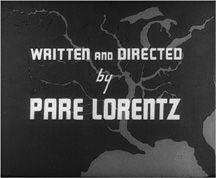
10.27
The River
begins with a map with the Mississippi River and its tributaries exaggerated in size.
Segment 2
continues the introduction with shots of the sky, mountains, and rivers. This motif of the majestic beauty of the Mississippi valley is repeated at the start of later sections and then contrasted with the bleak landscapes that dominate the middle parts of the film. As we see the beauty of the river
(
10.28
),
a resonant male voice tells us how water flows into the Mississippi from as far away as Idaho and Pennsylvania. The narrator’s rich voice accords with conventional notions of a trustworthy person. The narrator was Thomas Chalmers, an opera baritone chosen for just these qualities.
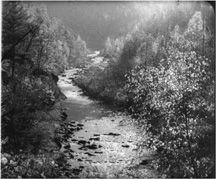
10.28 An idyllic image of nature in
The River.
Lorentz pays close attention to how the sound track can arouse emotion. While we see rivers swelling as they join, the narrator’s commentary is far from the dry, factual tone of most documentaries. The sentences have an urgent rhythm: “Down the Yellowstone, the Milk, the White, and Cheyenne … the Cannonball, the Musselshell, the James, and the Sioux.” This famous roll call of the rivers, recalling the teeming catalogues of Walt Whitman’s poetry, evokes the power and the grandeur of the land. Emotion is also aroused by the spacious folk-song score composed by Virgil Thompson. Thus the film adopts an American tone throughout, appealing to the viewer’s patriotic sentiments and implying that the whole country should face up to a particular regional problem.
Segment 2
has established an idyllic situation, with its beautiful images of mountain and river landscapes. The overall development of the film is toward a restoration of this beauty, but with a difference. With
segment 3
, we move into the section of the film devoted to facts of American history relating to the Mississippi and the problems it causes.
Segment 3
begins much as
segment 2
did, with a view of clouds. But now things begin to change. Instead of the mountains we saw earlier, we see mule teams and drivers. Again the narrator’s voice begins a list: “New Orleans to Baton Rouge … Baton Rouge to Natchez … Natchez to Vicksburg.” This list is part of the brief recounting of the history of the dikes built along the Mississippi to control flooding in pre–Civil War days. The narrator is confirmed as trustworthy and knowledgeable, giving us facts and dates in the nation’s history. We see cotton bales loaded onto steamboats, giving a sense of the country’s early strength as an exporter of goods. The brisk cutting here, as elsewhere in the film, evokes American enterprise and energy. Graphic discontinuity suggests both change and continuity when Lorentz cuts from a mud-filled sledge
(
10.29
)
to a plow thrusting in the opposite direction
(
10.30
).
The different movements suggest a shift in technology, but their similarities suggest the connection between building a dike and farming cotton. Dynamic compositions perform a similar service, as when a canted framing shows workers loading cotton bales onto a steamboat
(
10.31
).
The off-balance composition, accompanied by sprightly banjo music, makes the bales seem to roll downhill almost effortlessly.
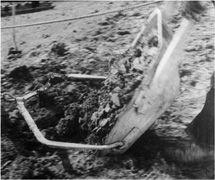
10.29
The River
creates graphic contrast between a sledge …
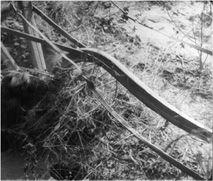
10.30 … and a plow.
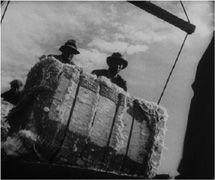
10.31 A canted framing in
The River.